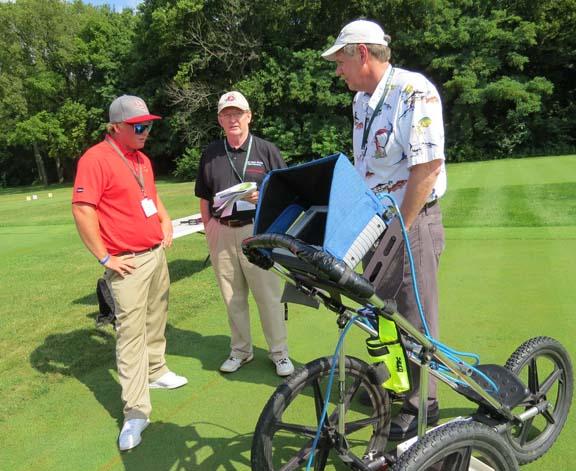
Researchers at a recent university field day believe that powerful, ground-penetrating radar might one day help superintendents gain a better understanding of just what lies beneath the surface at their golf course.
"Originally, our research focused on being able to map infrastructure at the base of the greens, particularly drainage systems, sand and gravel," said Barry Allred, Ph.D., of the U.S. Department of Agriculture. "Recently, we've been looking at it to map water content in the sand layer."
Allred and others from the Soil Drainage Research Unit of the USDA's Agricultural Research Service, have been testing ground-penetrating radar at two Columbus-area golf courses and demonstrated the technology's capabilities for others at the recent Ohio Turfgrass Foundation-Ohio State Turfgrass Research Field Day in Columbus.
Unlike hand-held meters that measure moisture content through the rootzone, ground-penetrating radar can go much deeper, and thus can detect structural deficiencies that might otherwise go undetected.
Ground-penetrating radar can rapidly measure and map bulk water content over vast and deep areas. The unit Allred was demonstrating at Ohio State, the SIR 3000 developed by Geophysical Survey Systems Inc. of Nashua, New Hampshire, can measure and map bulk water content from the surface to the base of the sand layer by emitting ground-piercing radar signals and measuring the time it takes to travel to and from the unit's antenna.
"It can differentiate between sand, native soil and gravel," Allred said.
"It measures the values of depths at various locations, the spatial variation across the green, whether it is draining well or staying wet."
The unit on display at Ohio State was mounted onto a three-wheeled device that looks like a steroid-enhanced baby stroller. And that mobility allows it to cover a large area in short order.
"If you have overly wet spots, you can put in localized drainage. If you have overly dry spots, you can hand water," said Ed McCoy, Ph.D., associate professor at Ohio State. "The goal would be to have this unit mounted onto a mower. Every day the mower goes across a green, it would spit out a map to the computer screen, calculate differences from one day to another and find tendencies."
A 2002 University of Berlin study by Stoffregen, Yaramanci, Zenker and Wessolek showed that ground-penetrating radar could measure water content in the soil at depths up to 5 feet. The technology is expensive, with a start-up cost, Allred said of $25,000-$30,000.
Despite the capabilities of GPR, handheld meters that operate on technology known as time-domain reflectometry are used on a wider scale, and it's not just because TDR meters have a lower cost point.
Research studies conducted by scientists at the Berkeley National Research Laboratory (Huisman, Hubbard, Redman and Annan in 2003 and Lunt, Hubbard and Rubin in 2005) as well as Kennesaw State University in Georgia indicate that TDR technology, which also measures then quantifies reflected waves, produces data that is as reliable or even exceeds that produced by GPR.
Where GPR has an advantage, said Ohio State's McCoy, is that it can detect problems with greens construction that are not detectable any other way. He also admitted that the cost means it will be years, if ever, that it makes inroads into golf.
"It can pick up problems on greens due to construction issues; cases where the integrity of the interface between the sand and gravel is disrupted for some reason and therefore never formed a perched water table, and therefore there is always a localized wet problem or dry problem," said McCoy.
"If we can incorporate this onto a mower, we will be able to get a much more rapid collection of data, each data point will cost substantially less money. There is an initial investment, but it gets cheaper over the long term."

